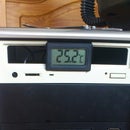Introduction: 5 Minute RC Car Conversion to Lithium Battery
Most toys are powered by AA batteries for ease of use and cost savings. But AA batteries are expensive to replace each time, and rechargeable ones (NiCd) are slow to recharge and have a poor lifetime. So the logical thing is to mod your RC car to run on lithium-ion batteries. This is not an easy task, lithium batteries need to be handled with care, you need a protection circuit, step-up converter etc.
The solution is to use a ready made lithium battery pack. Where do you find that? An external battery pack!
Parts list
- Portable battery pack/charger (can be disconnected from the project)
- USB male connector
- about 20 cms of double wiring
- Tape
- Soldering iron
- Small Phillips screwdrive
Step 1: Check and Connect the Wires
First check if the portable charger will work with your RC car. One of the main benefits of using a portable charger is that is has a built-in step-up converter converting the 3.7V lithium cell voltage to 5V output. This model RC car ran on 4 AA cells in series, which can be 1.2V (NiCD) or 1.5V (Alkaline). This makes a total of 4.8-6V input voltage. So 5V is perfect.
Connecting the wires
There are two ways to do this:
- Open up the RC car, find the power input wires and solder your new wires on there.
- Solder/clamp the new wires to the outside of the AA battery connectors.
I chose the first way as you can see, but for initial testing the second way is great. Now get your male usb cable and cut of the other end. Expose the metal for the four wires inside. Black is ground, red is positive and the other two wires are not needed for this project (they are for data transfer). Connect the corresponding wires to the wires you connected to the RC car power inputs. I used male-female breadboard wires, so I soldered some male pins on my usb cable first, but you can also solder it directly.
Step 2: Fix the Battery and Conclusion
For testing I put the battery on the front bumper, but this is not really great for the traction of a RWD car. Therefore it had to be on the roof. Using some LEGO and duct tape I made a simple rig for the battery.
There was enough room for the battery inside the chassis, but for accessibility reasons I made the choice to leave it outside.
Findings
The battery pack I used had a listed capacity of 2300 mAh. After half an hour of driving it was still running (and after that I got bored). A small issue is that the car would go about stuttering sometimes as if it wasn't able to draw enough power. I suspect the maximum discharge rate of the pack isn't high enough. But once it's going the car seems to accelerate to higher speeds than on AA batteries.













